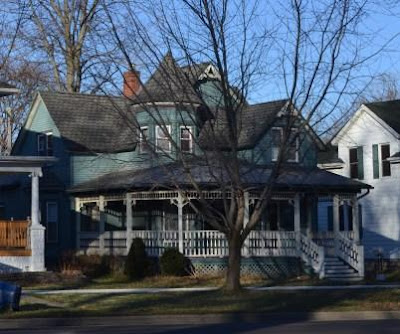
The home on the left was constructed for Frederick and Lucinda Hill in about 1889 in the Queen Anne style. Hill was the proprietor of W. W. Hill & Son, Bakers and Confectioners. Frederick was the son of William W. Hill, who began the bakery in downtown Plymouth in 1855. Frederick was born in Plymouth in 1857. He was the manager of the Central Union Telephone Company in Danville, Illinois until his association with his father’s bakery. Frederick Hill constructed a downtown business block for the bakery; it has a second and third story meeting hall used by the Knights of Pythias, of which he was a member. The building currently houses the Historic Crossroads Center of the Marshall County Museum. The house was recorded in Wilbur Peat’s book Indiana Houses of the Nineteenth Century. Peat describes the house as Neo-Jacobean and states “so massive a roof on a story and a half house gives the impression the walls are struggling to support excessive weight.” At the time the book was written the house was owned by Harvey Phillips.
The Stevens Home was constructed in 1895 in a blend of the Queen Anne and Shingle styles (above-middle). Smith (S. N.) and Martha Martin Stevens and their children Katherine and George F. had this home constructed for them in 1895. Smith and Martha were married in 1893. Smith came to Plymouth from Argos, Indiana in 1884 after receiving an education from Valparaiso University. He was admitted to the bar and began to practice law that same year. He was the Marshall County prosecuting attorney from 1890-1894 and 1897-1904. He was a member of the Plymouth School Board from 1900-1906. He held the office of Democratic County Chairman, Chairman of the 13th Congressional District, and member of the Democratic State Central Committee. Smith Stevens was the attorney for the State Bank of Plymouth as well as the local representing attorney for three railroads in the city. In 1914 he was elected Judge of the Judicial Court Circuit; he held that office until 1920. He practiced law afterward until his death in 1930. His wife, Martha, continued to reside at the home into the 1950s.

The Stevens Home was constructed in 1895 in a blend of the Queen Anne and Shingle styles (above-middle). Smith (S. N.) and Martha Martin Stevens and their children Katherine and George F. had this home constructed for them in 1895. Smith and Martha were married in 1893. Smith came to Plymouth from Argos, Indiana in 1884 after receiving an education from Valparaiso University. He was admitted to the bar and began to practice law that same year. He was the Marshall County prosecuting attorney from 1890-1894 and 1897-1904. He was a member of the Plymouth School Board from 1900-1906. He held the office of Democratic County Chairman, Chairman of the 13th Congressional District, and member of the Democratic State Central Committee. Smith Stevens was the attorney for the State Bank of Plymouth as well as the local representing attorney for three railroads in the city. In 1914 he was elected Judge of the Judicial Court Circuit; he held that office until 1920. He practiced law afterward until his death in 1930. His wife, Martha, continued to reside at the home into the 1950s.

Dr. Thomas and Gertrude Eley and their son Thomas Jr. had this home constructed for them in 1935 in the Colonial Revival style. It is one of the newest homes on Michigan Street. The Pilot News carried an article on the home when it was constructed. It was called a FHA Model Home in the article. Dr. Eley was a medical doctor and surgeon. They lived at 825 N. Michigan in 1930 prior to building this home. Dr. Eley was the secretary of the Plymouth Kiwanis Club when it formed in 1921. Mrs. Eley was a founding member of the Plymouth Tri Kappa in 1946. Mrs. Eley continued to live in the home after her husband’s death. She lived in the home she called the “Candlelight House” into the 1950s.

Who hasn't enjoyed this little cottage? It was constructed in about 1895 in the Queen Anne style. Joseph and Alice Anderson are listed at this address in the 1910 and 1920 censuses. Joseph’s occupation in 1910 was listed under commercial trade “brewery” and in 1920 as a manufacturer of cigars at home.


3 comments:
To members of my generation that will always be the Harvey Phillips House.
"Where have all the Entrepeneurs gone?"
I love that you're doing this. For some reason we just don't seem to have a lot of "Hoosier" dedicated blogs. The homes and their histories are great!
Kassie aka "Mom"
author of "Maybe someone should write that down..."
Thanks Kassie. I've been trying to get back to blogging after far too long of a break-too much work!
Post a Comment